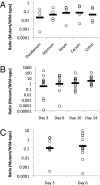L-fucose utilization provides Campylobacter jejuni with a competitive advantage
- PMID: 21482772
- PMCID: PMC3084102
- DOI: 10.1073/pnas.1014125108
L-fucose utilization provides Campylobacter jejuni with a competitive advantage
Abstract
Campylobacter jejuni is a prevalent gastrointestinal pathogen in humans and a common commensal of poultry. When colonizing its hosts, C. jejuni comes into contact with intestinal carbohydrates, including L-fucose, released from mucin glycoproteins. Several strains of C. jejuni possess a genomic island (cj0480c-cj0490) that is up-regulated in the presence of both L-fucose and mucin and allows for the utilization of L-fucose as a substrate for growth. Strains possessing this genomic island show increased growth in the presence of L-fucose and mutation of cj0481, cj0486, and cj0487 results in the loss of the ability to grow on this substrate. Furthermore, mutants in the putative fucose permease (cj0486) are deficient in fucose uptake and demonstrate a competitive disadvantage when colonizing the piglet model of human disease, which is not paralleled in the colonization of poultry. This identifies a previously unrecorded metabolic pathway in select strains of C. jejuni associated with a virulent lifestyle.
Conflict of interest statement
The authors declare no conflict of interest.
Figures





Similar articles
-
Phenotypic and genotypic evidence for L-fucose utilization by Campylobacter jejuni.J Bacteriol. 2011 Mar;193(5):1065-75. doi: 10.1128/JB.01252-10. Epub 2010 Dec 30. J Bacteriol. 2011. PMID: 21193610 Free PMC article.
-
L-fucose influences chemotaxis and biofilm formation in Campylobacter jejuni.Mol Microbiol. 2016 Aug;101(4):575-89. doi: 10.1111/mmi.13409. Epub 2016 Jun 10. Mol Microbiol. 2016. PMID: 27145048
-
Bacteroides fragilis fucosidases facilitate growth and invasion of Campylobacter jejuni in the presence of mucins.Cell Microbiol. 2020 Dec;22(12):e13252. doi: 10.1111/cmi.13252. Epub 2020 Sep 21. Cell Microbiol. 2020. PMID: 32827216 Free PMC article.
-
Defining the metabolic requirements for the growth and colonization capacity of Campylobacter jejuni.Front Cell Infect Microbiol. 2014 Sep 29;4:137. doi: 10.3389/fcimb.2014.00137. eCollection 2014. Front Cell Infect Microbiol. 2014. PMID: 25325018 Free PMC article. Review.
-
A tolerogenic mucosal immune response leads to persistent Campylobacter jejuni colonization in the chicken gut.Crit Rev Microbiol. 2012 Feb;38(1):17-29. doi: 10.3109/1040841X.2011.615298. Epub 2011 Oct 13. Crit Rev Microbiol. 2012. PMID: 21995731 Review.
Cited by
-
Identification of O-glycan Structures from Chicken Intestinal Mucins Provides Insight into Campylobactor jejuni Pathogenicity.Mol Cell Proteomics. 2015 Jun;14(6):1464-77. doi: 10.1074/mcp.M114.044867. Epub 2015 Mar 16. Mol Cell Proteomics. 2015. PMID: 25776888 Free PMC article.
-
The chbG gene of the chitobiose (chb) operon of Escherichia coli encodes a chitooligosaccharide deacetylase.J Bacteriol. 2012 Sep;194(18):4959-71. doi: 10.1128/JB.00533-12. Epub 2012 Jul 13. J Bacteriol. 2012. PMID: 22797760 Free PMC article.
-
Proteomic and genomic analysis reveals novel Campylobacter jejuni outer membrane proteins and potential heterogeneity.EuPA Open Proteom. 2014 Jun 26;4:184-194. doi: 10.1016/j.euprot.2014.06.003. eCollection 2014 Sep. EuPA Open Proteom. 2014. PMID: 27525220 Free PMC article.
-
Comparison of genomes and proteomes of four whole genome-sequenced Campylobacter jejuni from different phylogenetic backgrounds.PLoS One. 2018 Jan 2;13(1):e0190836. doi: 10.1371/journal.pone.0190836. eCollection 2018. PLoS One. 2018. PMID: 29293692 Free PMC article.
-
Bacterial AB5 toxins inhibit the growth of gut bacteria by targeting ganglioside-like glycoconjugates.Nat Commun. 2019 Mar 27;10(1):1390. doi: 10.1038/s41467-019-09362-z. Nat Commun. 2019. PMID: 30918252 Free PMC article.
References
Publication types
MeSH terms
Substances
LinkOut - more resources
Full Text Sources
Other Literature Sources
Molecular Biology Databases

